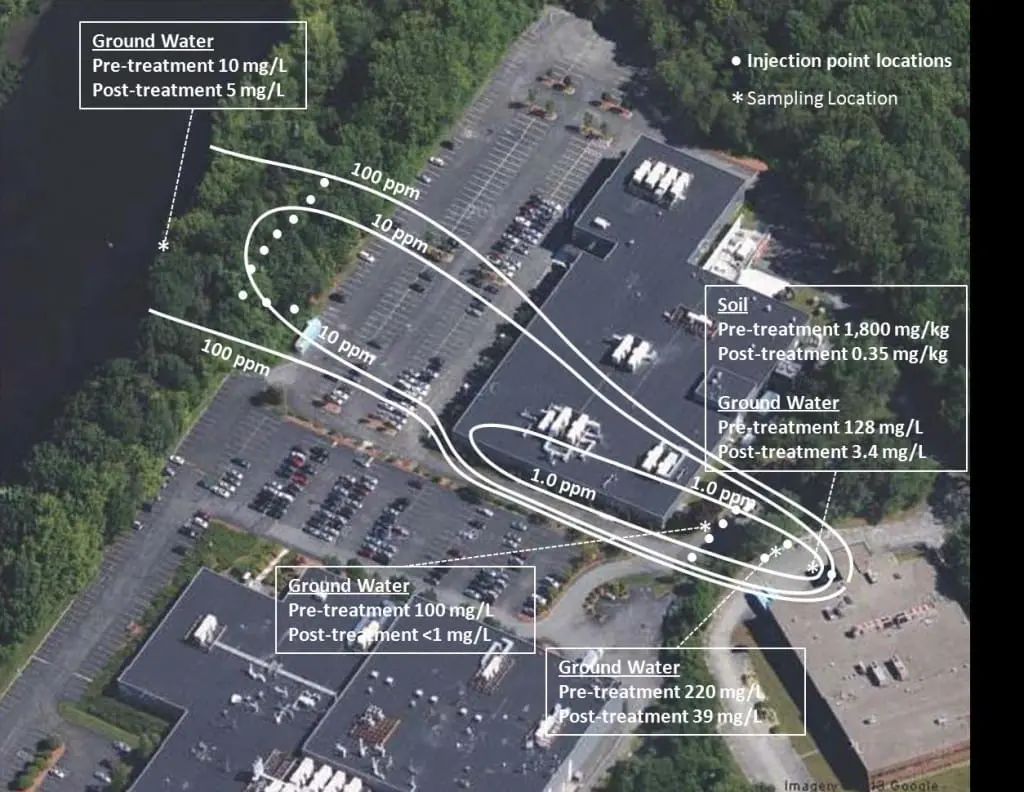Perchlorate Bioremediation in Soil and Ground Water
Site Summary
CL-Out® perchlorate bioremediation was implemented at a confidential manufacturing site to remediate perchlorate concentrations in soil and ground water. After careful treatability testing and a source area pilot study, full-scale application of CL-Out® bioremediation reduced the perchlorate concentration in the soil by more than 99.9% and in ground water by approximately 99%. The remediation provided immediate risk reduction and mitigated potential off-site migration. Current results trend toward achieving applicable standards in soil and ground water in an accelerated timeframe. The property sold without environmental impairment upon completion of bioremediation.
Project Design and Implementation
Following the discovery of perchlorate in soil and ground water near a former storage area, a hydraulic extraction system was installed to contain the perchlorate ground water plume. CL-Out® bioremediation was then tested to determine applicability to remediate the site by in situ treatment and to eliminate the need for ground water containment. After a successful treatability study, a pilot study was implemented in the source area to test field applicability and to reduce concentrations in the impacted source area soil.
One of the key factors in CL-Out® cometabolism of perchlorate at this site was that CL-Out® organisms were able to reduce sequentially the oxygen and nitrate prior to perchlorate. The initial nitrate concentrations were typically much higher than the perchlorate concentrations. The perchlorate concentration did not decrease until the nitrate concentration decreased to less than the perchlorate concentration. One of the benefits of the CL-Out® organisms was this ability to utilize these different electron acceptors.
The source area soil was treated with the application of CL-Out® through a surface infiltration system. Five to 10 gallons of CL-Out® was applied through a percolation trench three times and allowed to seep through 30 cubic yards of impacted soil. An extraction well recovered the ground water. After six months the perchlorate concentration in the source area soils were reduced from 1,800 mg/kg to 8 mg/kg and to 0.35 mg/kg after 8 months.
Ground water samples taken from the source area extraction well showed a decrease in perchlorate concentrations during the soil treatment. Prior to the soil treatment the extracted ground water had a perchlorate concentration of 0.3 mg/L. At 6 months the perchlorate concentration in ground water decreased to 0.2 mg/L. After 8 months, the perchlorate concentration decreased to 0.1 mg/L. These results confirmed that the perchlorate was destroyed in situ and not flushed from the soil.
After successful source treatment, CL-Out® bioremediation was initiated in the ground water plume. Perchlorate is present in both an unconsolidated overburden aquifer and bedrock aquifer. The perchlorate plume is approximately 3 acres with a maximum detected concentration greater than 300 mg/L. High nitrate concentrations were associated with the high perchlorate concentrations. The aquifer is aerobic with high dissolved oxygen levels in both the overburden and bedrock aquifers. The application of CL-Out® cometabolism first reduced the oxygen and nitrate prior to reducing the perchlorate. The ground water pH was low and required buffering to prevent potential microbial growth limitations.
The aquifer amendments and bioaugmentation solution were introduced into the aquifer through temporary injection wells in lines at key locations perpendicular to the ground water flow. Before the bioaugmentation, a weak base was added to buffer the ground water pH. Then, CL-Out® microbes were injected in the aquifer in a solution with dextrose as a cometabolic substrate.
The unconsolidated aquifer was inoculated with CL-Out® through nine injection points near the plume front and seven injection points down gradient from the source area. Twenty-five to 110 gallons of CL-Out® were injected near the source area in three events between July and November 2012. One hundred total gallons of CL-Out® were injected near the plume front between August and November 2012.
Ground water in bedrock was treated by inoculation with CL-Out® at one injection point on three occasions. The inoculation volume was 25, 7 then 5 gallons in November 2012, June and July 2013.
Results
Periodic post–treatment ground water samples were taken from several monitoring wells to track the progress of bioremediation and to monitor the microbial population and growth conditions. In eight months, the perchlorate concentration in the unconsolidated aquifer was reduced from 128 mg/L to 3.4 mg/L immediately down gradient of the source area and from 220 mg/L to 39 mg/L farther down gradient. The perchlorate concentration near the first set of plume injection points decreased from 100 to <1.0 mg/L. At the plume front the perchlorate concentration decreased from 10 to 5.0 mg/L. The perchlorate concentration in the bedrock decreased from an average of 5 mg/L pretreatment to <0.3 mg/L.
As the perchlorate was removed, the CL-Out® microbes also removed the nitrate. Down gradient of the source area the nitrate concentration decreased from 105 mg/L to <1.0 mg/L. Farther down gradient the nitrate concentration decreased from 200 mg/L to 5 mg/L.
Field application of CL-Out® has rapidly reduced mass and concentrations by orders of magnitude, achieving plume containment and significant savings over hydraulic containment and ex-situ treatment. The remediation is in progress, but these early results confirm the successful application of CL-Out® bioremediation to high concentrations of perchlorate.


